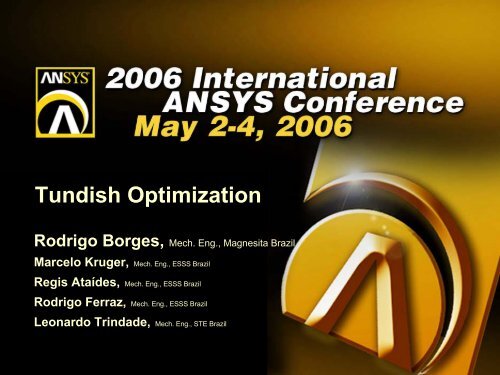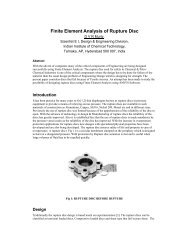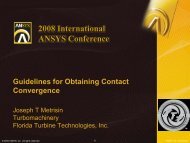Tundish Optimization - Ansys
Tundish Optimization - Ansys
Tundish Optimization - Ansys
You also want an ePaper? Increase the reach of your titles
YUMPU automatically turns print PDFs into web optimized ePapers that Google loves.
<strong>Tundish</strong> <strong>Optimization</strong><br />
Rodrigo Borges, Mech. Eng., Magnesita Brazil<br />
Marcelo Kruger, Mech. Eng., ESSS Brazil<br />
Regis Ataídes, Mech. Eng., ESSS Brazil<br />
Rodrigo Ferraz, Mech. Eng., ESSS Brazil<br />
Leonardo Trindade, Mech. Eng., STE Brazil<br />
© 2006 ANSYS, Inc.<br />
ANSYS, Inc. Proprietary
Magnesita – The company<br />
– Brazilian company providing solutions for the metallurgic market<br />
– Technological development in:<br />
• Raw materials for refractories<br />
• Metallurgical fluxes<br />
• Refractory products<br />
• Mechanisms<br />
• Numerical simulation<br />
– Also providing technical and laboratory support for subsidiaries,<br />
production, marketing and quality control.<br />
© 2006 ANSYS, Inc.<br />
ANSYS, Inc. Proprietary
Magnesita and ESSS<br />
• Numerical Simulation:<br />
– Good interaction with ESSS (ANSYS<br />
distributor in South America)<br />
– Some Analyses Performed:<br />
• Open nozzle continuous casting<br />
• Submerged entry nozzle<br />
• Structural analyses of a steel ladle<br />
• <strong>Tundish</strong> flow analyses<br />
© 2006 ANSYS, Inc.<br />
ANSYS, Inc. Proprietary
Continuous Casting - <strong>Tundish</strong><br />
Inlet<br />
<strong>Tundish</strong> (region of interest) Outlet<br />
© 2006 ANSYS, Inc.<br />
Inlet<br />
Outlet<br />
Residence time is the key point:<br />
•Separation of inclusions<br />
•Cold spots (solidification)<br />
ANSYS, Inc. Proprietary
Continuous Casting - <strong>Tundish</strong><br />
• There are different ways to obtain a <strong>Tundish</strong>’s<br />
Residence Time Distribution (RTD):<br />
– Using a Tracer<br />
• Injecting tracer as a step function and monitoring its<br />
concentration as a function of time at the outlets<br />
– Lagrangean models<br />
• Monitoring particles traveling time at the outlets<br />
– Solving for Age<br />
Largely compared with<br />
experimental data<br />
• Additional variable that represents residence time<br />
© 2006 ANSYS, Inc.<br />
ANSYS, Inc. Proprietary
Continuous Casting - <strong>Tundish</strong><br />
• Residence Time Distribution methodology<br />
Ct[Kg/m ]<br />
Outlet<br />
3<br />
t min<br />
t [s]<br />
Ct<br />
3<br />
[Kg/m ]<br />
Inlet<br />
Ct<br />
3<br />
[Kg/m ]<br />
Average Residence Time<br />
Big enough Ideal<br />
Min. Residence Time<br />
Not too small<br />
C<br />
t 1<br />
A passive scalar is Injected<br />
t [s]<br />
Ct<br />
t min<br />
3<br />
[Kg/m ]<br />
Average Residence Time<br />
Also Small<br />
Short Circuit<br />
Min. Residence Time<br />
Too small<br />
t [s]<br />
Average Residence Time<br />
Big Enough<br />
Min. Residence The Time Stagnated curve lasts<br />
Too small<br />
too (cold) long Regions<br />
t [s]<br />
t min<br />
© 2006 ANSYS, Inc.<br />
ANSYS, Inc. Proprietary
Continuous Casting - <strong>Tundish</strong><br />
• Characteristic Volumes:<br />
– Plugged Volume<br />
– Dead Volume<br />
Ct<br />
3<br />
[Kg/m ]<br />
t min<br />
t ave<br />
Average RT<br />
2*Average RT<br />
Area = Dead Volume<br />
t [s]<br />
To be<br />
Maximized<br />
To be<br />
Minimized<br />
t min<br />
© 2006 ANSYS, Inc.<br />
ANSYS, Inc. Proprietary
Continuous Casting - <strong>Tundish</strong><br />
• To provide a better control over Residence Time<br />
Distribution, baffles are positioned along the<br />
domain.<br />
Baffles<br />
© 2006 ANSYS, Inc.<br />
ANSYS, Inc. Proprietary
<strong>Tundish</strong> <strong>Optimization</strong><br />
• Baffle Designs are well suitable for optimization<br />
tools:<br />
– Finding the optimum point is a hard process due to<br />
non-linearity of the Navier-Stokes Equations and the<br />
two conflicting objectives;<br />
– CFD analyses provide an easy way to inspect<br />
different baffle configurations;<br />
– Automatic mesh generation can be easily overcome<br />
with ANSYS ICEM CFD.<br />
© 2006 ANSYS, Inc.<br />
ANSYS, Inc. Proprietary
<strong>Tundish</strong> <strong>Optimization</strong><br />
• The case illustrated here represents a real<br />
problem solved by Magnesita and ESSS:<br />
– The problem is only ½ symmetric, decreasing the<br />
number of DOF<br />
and elements in the<br />
mesh<br />
– Two baffles need to<br />
be analyzed<br />
– RTD must be<br />
inspected at both<br />
outlets<br />
© 2006 ANSYS, Inc.<br />
ANSYS, Inc. Proprietary
<strong>Tundish</strong> <strong>Optimization</strong><br />
• To simplify the problem, only two design<br />
parameters were considered:<br />
– HB: Baffle Height<br />
– DB: Baffle Distance (from the outlet)<br />
HB<br />
HB<br />
DB<br />
DB<br />
© 2006 ANSYS, Inc.<br />
ANSYS, Inc. Proprietary
<strong>Tundish</strong> <strong>Optimization</strong><br />
• First step: Automatize the Evaluation process.<br />
Geometry Generation<br />
CATIA V5<br />
Unstructured Transient: mesh 1E-5 2500 with (approx. seconds, prisms 6h) 1E-5 (370k(approx. nodes) 26h)<br />
Mesh generation<br />
ANSYS ICEM CFD<br />
Solve for Flow<br />
ANSYS CFX<br />
modeFrontier<br />
• Process Integration<br />
• <strong>Optimization</strong> algorithms<br />
Solve Tracer<br />
ANSYS CFX<br />
© 2006 ANSYS, Inc.<br />
RTD Analyses<br />
MS Excel<br />
One evaluation: approx. 30h<br />
ANSYS, Inc. Proprietary
<strong>Tundish</strong> <strong>Optimization</strong><br />
• modeFrontier setup:<br />
Input Parameters<br />
Step 1: Geometry Step 2: Mesh Generation Step Generation 3: Solve Step for 4: Flow Solve Step Tracer 5: DTR Analyses<br />
Catia Direct ANSYS NodeICEM ANSYS CFDCFXANSYS CFX MS-Excel Direct Node<br />
Output Parameters<br />
(extracted from MS-Excel)<br />
© 2006 ANSYS, Inc.<br />
ANSYS, Inc. Proprietary
<strong>Tundish</strong> <strong>Optimization</strong><br />
• Since CFD analyses are computational demanding,<br />
a DOE and RSM (Response Surface) approach<br />
was adopted, saving computational time.<br />
– DOE table with 25 designs:<br />
• A Response Surface is created;<br />
– The <strong>Optimization</strong> process runs in the RSM<br />
• Virtual designs are founded;<br />
– Virtual designs are evaluated;<br />
© 2006 ANSYS, Inc.<br />
ANSYS, Inc. Proprietary
<strong>Tundish</strong> <strong>Optimization</strong><br />
• The DOE table was created uniformly along the<br />
Design Space:<br />
HB<br />
Design Space<br />
© 2006 ANSYS, Inc.<br />
DB<br />
ANSYS, Inc. Proprietary
<strong>Tundish</strong> <strong>Optimization</strong><br />
• After solving the DOE table statistical information<br />
may be extracted within modeFrontier, such as<br />
the Correlation Matrix:<br />
© 2006 ANSYS, Inc.<br />
ANSYS, Inc. Proprietary
<strong>Tundish</strong> <strong>Optimization</strong><br />
• With the results of the DOE table a Response<br />
Surface is created for each outlet and objective,<br />
using Kriging’s algorithm:<br />
– RSM for Plugged volume at Outlet 1<br />
– RSM for Plugged volume at Outlet 2<br />
– RSM for Dead volume at Outlet 1<br />
– RSM for Dead volume at Outlet 2<br />
© 2006 ANSYS, Inc.<br />
ANSYS, Inc. Proprietary
<strong>Tundish</strong> <strong>Optimization</strong><br />
• Plugged Volume – Outlet 1<br />
© 2006 ANSYS, Inc.<br />
ANSYS, Inc. Proprietary
<strong>Tundish</strong> <strong>Optimization</strong><br />
• Plugged Volume – Outlet 2<br />
© 2006 ANSYS, Inc.<br />
ANSYS, Inc. Proprietary
<strong>Tundish</strong> <strong>Optimization</strong><br />
• Dead Volume – Outlet 1<br />
© 2006 ANSYS, Inc.<br />
ANSYS, Inc. Proprietary
<strong>Tundish</strong> <strong>Optimization</strong><br />
• Dead Volume – Outlet 2<br />
© 2006 ANSYS, Inc.<br />
ANSYS, Inc. Proprietary
<strong>Tundish</strong> <strong>Optimization</strong><br />
Pluged<br />
Dead<br />
Outlet 2<br />
Outlet 1<br />
© 2006 ANSYS, Inc.<br />
ANSYS, Inc. Proprietary
<strong>Tundish</strong> <strong>Optimization</strong><br />
• Response Surface inspection indicate that the<br />
best designs:<br />
– Are closer to the outlets<br />
– Have higher baffles<br />
• A Multi-Objective algorithm (MOGA II) is used to<br />
extract the best results from the Response<br />
Surface<br />
– Only two Objectives: Maximize Plugged volume at<br />
both outlets (since Plugged and Dead volume are<br />
strongly correlated)<br />
© 2006 ANSYS, Inc.<br />
ANSYS, Inc. Proprietary
<strong>Tundish</strong> <strong>Optimization</strong><br />
• Virtual Designs (the more red, the newer)<br />
Plugged Volume 1<br />
Plugged Volume 2<br />
© 2006 ANSYS, Inc.<br />
ANSYS, Inc. Proprietary
<strong>Tundish</strong> <strong>Optimization</strong><br />
• Best Virtual Designs were located at the<br />
minimum distance from the outlets<br />
• Three Virtual Designs were chosen to be<br />
validated<br />
• The results were then compared to the<br />
initially suggested configuration (next<br />
Slide)<br />
© 2006 ANSYS, Inc.<br />
ANSYS, Inc. Proprietary
<strong>Tundish</strong> <strong>Optimization</strong><br />
• Best Designs x Original Design<br />
31<br />
30<br />
29<br />
(%)<br />
h1<br />
Outlet 1 Outlet 2<br />
h2<br />
(%)<br />
31<br />
Original Design<br />
30<br />
29<br />
28<br />
28<br />
h1<br />
Original Design<br />
h2<br />
h3<br />
27<br />
27<br />
h1<br />
Original Design<br />
26<br />
25<br />
24<br />
Original Design<br />
h1<br />
h3<br />
h3<br />
26<br />
25<br />
24<br />
h2<br />
23<br />
22<br />
h2<br />
HB<br />
23<br />
22<br />
HB<br />
h3<br />
Dead Volume<br />
Pluged Volume<br />
Dead Volume<br />
Pluged Volume<br />
© 2006 ANSYS, Inc.<br />
ANSYS, Inc. Proprietary
Conclusions<br />
• Baffles:<br />
– Better Residence Time Distribution were found with<br />
higher baffles and closer to the outlet<br />
– Increasing height will only improve results to a certain<br />
value<br />
• Characteristic Volumes:<br />
– Plugged and Dead volumes are strongly correlated.<br />
© 2006 ANSYS, Inc.<br />
ANSYS, Inc. Proprietary
Future Studies<br />
– Validate different methodologies for<br />
Residence Time Distribution calculation:<br />
• Lagragean Models<br />
• Solving Residence Time as a Scalar<br />
– Apply optimization techniques in other<br />
metallurgic components<br />
© 2006 ANSYS, Inc.<br />
ANSYS, Inc. Proprietary





